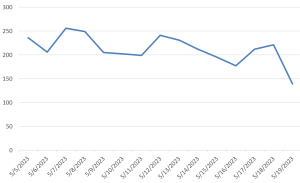LB-LINK Router Command Injection Vulnerability
LB-Link is a well-known company in the networking industry that specializes in the design, manufacturing, and distribution of wireless networking products. The company’s product portfolio includes a wide range of wireless routers, network adapters, Wi-Fi extenders, and other networking accessories.
A command injection vulnerability exists in LB-LINK’s BL-AC1900, BL-WR9000, BL-X26 and BL-LTE300 wireless routers.
Command Injection Vulnerability
The goal of a command injection attack is the execution of arbitrary commands on the host operating system via a vulnerable application. Command injection attacks are possible when an application passes unsafe user-supplied data (forms, cookies, HTTP headers etc.)
LB-LINK Routers Command Injection | CVE-2023-26801

As seen from the exploit, the command injection vulnerability is possible due to the insufficient input validation of the ‘mac’ parameter. In the payload the value ![]() is appended to the ‘mac’ parameter . This value is a command injection attempt. This parameter value attempts to execute the ‘telnetd’ command with the ‘l’ option to start a new login shell (/bin/sh). This is how an unauthorized attacker can send crafted requests to /goform/set_LimitClient_cfg, and execute arbitrary commands on remote devices.
is appended to the ‘mac’ parameter . This value is a command injection attempt. This parameter value attempts to execute the ‘telnetd’ command with the ‘l’ option to start a new login shell (/bin/sh). This is how an unauthorized attacker can send crafted requests to /goform/set_LimitClient_cfg, and execute arbitrary commands on remote devices.
Following LB-LINK’s router versions are vulnerable :
- BL-AC1900_2.0 V1.0.1
- BL-WR9000 V2.4.9
- BL-X26 V1.2.5
- BL-LTE300 V1.0.8
The CVSS (Common Vulnerability Scoring System) score is 9.8 with CVSS:3.1/AV:N/AC:L/PR:N/UI:N/S:U/C:H/I:H/A:H
- Attack vector is network.
- Attack complexity is low.
- Privileges required is none.
- User interaction is none.
- Scope is unchanged.
- Impact of this vulnerability on data confidentiality is high.
- Impact of this vulnerability on data integrity is high.
- Impact of this vulnerability on data availability is high.
SonicWall Capture Labs provides protection against this threat via following signature:
- IPS 15851:LB-LINK Routers Command Injection
Threat Graph

